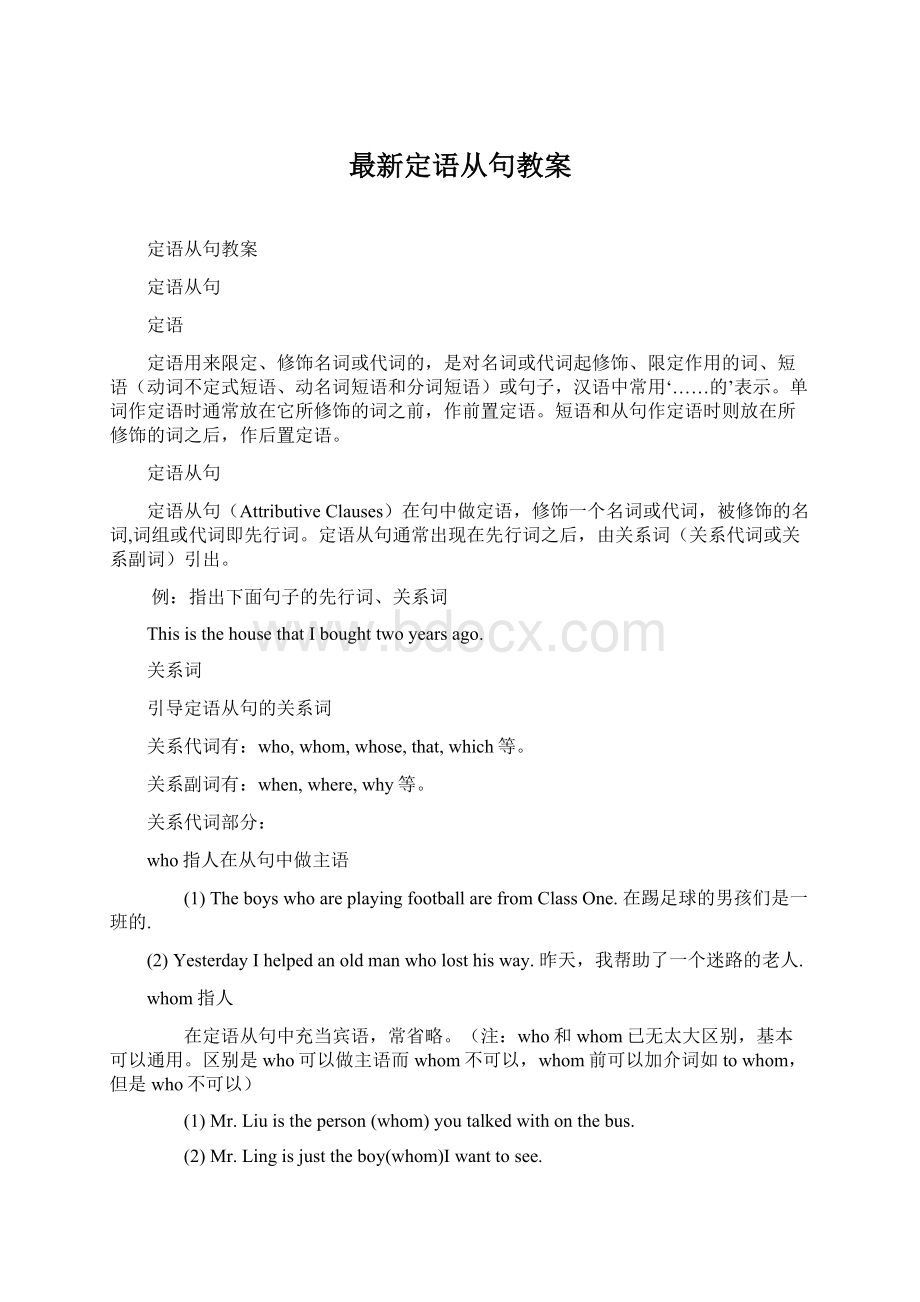最新定语从句教案Word格式.docx
《最新定语从句教案Word格式.docx》由会员分享,可在线阅读,更多相关《最新定语从句教案Word格式.docx(7页珍藏版)》请在冰豆网上搜索。

(2)YesterdayIhelpedanoldmanwholosthisway.昨天,我帮助了一个迷路的老人.
whom指人
在定语从句中充当宾语,常省略。
(注:
who和whom已无太大区别,基本可以通用。
区别是who可以做主语而whom不可以,whom前可以加介词如towhom,但是who不可以)
(1)Mr.Liuistheperson(whom)youtalkedwithonthebus.
(2)Mr.Lingisjusttheboy(whom)Iwanttosee.
(3)Themanwho/whomyoumetjustnowismyfriend.
whose通常指人也可指物
在定语从句中做定语,表所有。
(1)Hehasafriendwhosefatherisadoctor.
(2)Ioncelivedinahousewhoseroofhasfallenin.
whose指物时通常以以下结构来代替
(3)Theclassroomwhosedoorisbrokenwillsoonberepaired.
(4)Theclassroomthedoorofwhichisbrokenwillsoonberepaired.
(5)Doyoulikethebookwhosecolorisyellow?
(6)Doyoulikethebookthecolorofwhichisyellow?
which指物
在定语从句中做主语,表语,定语或者宾语,做宾语时可省略。
在非限制性定语从句中有“,”即可用which
(1)Footballisagamewhichislikedbymostboys.足球是大多数男孩都喜欢的游戏.
(2)Thisisthepen(which)heboughtyesterday.这是他昨天刚买的钢笔.
That
指人时相当于who或者whom;
指物时,相当于which。
在定语从句中做主语,表语或者宾语,做宾语时可省略。
(5)Thenumberofthepeoplethat/whocometovisitthecityeachyearrisesonemillion.
(6)Whereisthemanthat/whomIsawthismorning?
That与which的区别
1)不用that的情况
a)在引导非限定性定语从句时。
Thetree,thatisfourhundredyearsold,isveryfamoushere.
b)介词后不能用。
Wedependonthelandfromwhichwegetourfood.
Wedependonthelandthat/whichwegetourfoodfrom.
2)只能用that作为定语从句的关系代词的情况
a) 在therebe句型中,只用that,不用which。
b) 在不定代词,如:
anything,nothing,theone,all,much,few,any,little等作先行词时,只用that,不用which。
Allthatisneededisasupplyofoil.
c) 先行词有theonly,thevery修饰时,只用that。
Theonlythingthatthestudentscandoisstudyinghard
d) 先行词为序数词、数词、形容词最高级时,只用that。
.
ThisisthefirstAmericanfilmthatI'
veeverseen
e)先行词既有人,又有物时。
关系副词部分:
when指时间
在定语从句中做时间状语也可做连接词用
(1)IstillrememberthedaywhenIfirstcametotheschool.
(2)Thetimewhenwegottogetherfinallycame.
注意:
表示时间“time"
一词的定语从句只用when引导,有时不用任何关系代词,当然也不用that引导。
例:
1.BythetimewhenyouarrivedinLondon,wehadstayedtherefortwoweeks.
2.Istillrememberthefirsttime(when)Imether.
3.Eachtimewhenhegoestobusinesstrip,hebringsalotoflivingnecessities,suchastowels,soap,toothbrushetc.
Where指地点
在定语从句中做地点状语
(1)ShanghaiisthecitywhereIwasborn.
(2)ThehousewhereIlivedtenyearsagohasbeenpulleddown.
why指原因
在定语从句中做原因状语
(1)Pleasetellmethereasonwhyyoumissedtheplane.
(2)Idon’tknowthereasonwhyhelooksunhappytoday.
限制性和非限制性定语从句
定语从句有限制性和非限制性两种。
限制性定语从句是先行词不可缺少的部分,去掉它主句意思往往不明确;
非限制性定语从句是先行词的附加说明,去掉了也不会影响主句的意思,它与主句之间通常用逗号分开
Thisisthehousewhichweboughtlastmonth. (限制性)
Thehouse,whichweboughtlastmonth,isverynice.(非限制性)
当先行词是专有名词或物主代词和指示代词所修饰时,其后的定语从句通常是非限制性的,例:
CharlesSmith,whowasmyformerteacher,retiredlastyear.
Myhouse,whichIboughtlastyear,hasgotalovelygarden.
Thisnovel,whichIhavereadthreetimes,isverytouching.
非限制性定语从句还能将整个主句作为先行词,对其进行修饰,这时从句谓语动词要用第三人称单数,例:
HeseemsnottohavegraspedwhatImeant,whichgreatlyupsetsme.
Liquidwaterchangestovapor,whichiscalledevaporation.
在非限定性定语从句中,不能用关系副词why和关系代词that,而用who,whom代表人,用which,whose代表事物,如果需要用why,可用forwhich代替.which引导的非限制性定语从句其后不可省成分,as可以.
as引导非限制性定语从句时,可以代主句的全部或部分内容。
常表说话人关于说话的依据、态度、评论、看法等。
有“正如、像”等意思。
定语从句可以置主句句首(注意这点与which的区别)、句中或句末。
as后常接expect,know,report,say,see等动词的主、被动语态句。
例:
Mike,asweexpected,attendedthemeeting.
像我们所期望的那样,迈克参加了会议。
由as,which引导的非限定性定语从句,as和which可代整个主句,相当于andthis或andthat。
As一般放在句首,which在句中。
Asweknow,smokingisharmfultoone'
shealth.
Thesunheatstheearth,whichisveryimportanttous. 1)Alicereceivedaninvitationfromherboss,___cameasasurprise.
A.it B.that C.which D.he
2)Theweatherturnedouttobeverygood,___wasmorethanwecouldexpect.
A.what B.which C.that D.it
3)Itrainedhardyesterday,____preventedmefromgoingtothepark..
A.that B.which C.as D.it
as和which在引导非限制性定语从句时,这两个关系代词都指主句所表达的整个意思,且在定语从句中都可以作主语和宾语。
但不同之处主要有两点:
(1)as引导的定语从句可置于句首,而which不可。
(2)as代表前面的整个主句并在从句中作主语时,从句中的谓语必须是系动词;
若为行为动词,则从句中的关系代词只能用which.。
在本题中,prevent由于是行为动词,所以正确选项应为B。
As的用法例
1.thesame…as;
such…as中的as是一种固定结构,和……一样……。
Ihavegotintothesametroubleashe(has).
例2.as可引导非限制性从句,常带有'
正如'
。
Asweknow,smokingisharmfultoone'
Asisknown,smokingisharmfultoone'
As是关系代词。
例1中的as作know的宾语;
如何区分关系代词和关系副词?
?
方法一:
用关系代词,还是关系副词完全取决于从句中的谓语动词。
及物动词后面无宾语,就必须要求用关系代词;
而不及物动词则要求用关系副词。
例如:
ThisisthemountainvillagewhereIstayedlastyear.
I'
llneverforgetthedayswhenIworkedtogetherwithyou.
(F)ThisisthemountainvillagewhereIvisitedlastyear.
(F)IwillneverforgetthedayswhenIspentinthecountryside.
(T)Thisisthemountainvillage(which)Ivisitedlastyear.
(T)I'
llneverforgetthedays(which)Ispentinthecountryside.
习惯上总把表地点或时间的名词与关系副词where,when联系在一起。
此两题错在关系词的误用上。
方法二:
准确判断先行词在定语从句中的成分(主、谓、宾、定、状),也能正确选择出关系代词/关系副词。
例1.Isthismuseum___youvisitedafewdaysage?
A.where B.that C.onwhich D.theone
例2.Isthisthemuseum____theexhibitionwasheld.
介词与关系代词
1.当介词放在关系代词前面时,关系代词只能用which/whom即“介词+which/whom"
且不能省略。
但当介词位于末尾时可用that/which/who/whom.作介词的宾语,且可以省略。
Theschool(that/which)heoncestudiedinisveryfamous."
that/which"
可以省略
=Theschoolinwhichheoncestudiedisveryfamous."
which”不可省略
[误]Thisistheroominthattheoldmanlives
[正]Thisistheroominwhichtheoldmanlives
[正]Thisistheroomwhichtheoldmanlivesin
[正]Thisistheroomthattheoldmanlivesin
含有介词的动词短语一般不拆开使用,如:
lookfor,lookafter,takecareof等
TThisisthewatchwhich/thatIamlookingfor.
FThisisthewatchforwhichIamlooking.
2.若介词放在关系代词前,关系代词指人时用whom,不可用who或者that;
指物时用which,不能用that;
关系代词是所有格时用whose
(1)Themanwithwhomyoutalkedismyfriend.(T)
Themanwiththatyoutalkedismyfriend.(F)
(2)TheplaneinwhichweflewtoCanadaisverycomfortable.(T)
TheplaneinthatweflewintoCanadaisverycomfortable.(F)
3.“介词+关系代词”前可有some,any,none,both,all,neither,most,each,
few等代词、数词或者名词。
(1)Helovedhisparentsdeeply,bothofwhomareverykindtohim.
(2)Inthebaskettherearequitemanyapples,someofwhichhavegonebad.
(3)Therearefortystudentsinourclassinall,mostofwhomarefrombigcities.
(4)Theboat,thenameofwhichisTopsail,isfamous.
(5)Iboughtmanybooksyesterday,threeofwhicharewrittenbyLuXun.
先行词和关系词二合一
1)Whoeverspitsinpublicwillbepunishedhere.
(Whoever可以用anyonewho代替)
2)Theparentswillusewhattheyhavetosendtheirsontotechnicalschool.
(what可以用allthat代替)
3)what=thethingwhich;
whatever=anything
Whatyouwanthasbeensenthere.
Whateveryouwantmakesnodifferencetome.
4)who=thepersonthat whoever=anyonewho
(错)Whobreaksthelawwillbepunished.
(错)Whoeverrobbedthebankisnotclear.
(对)Whoeverbreaksthelawwillbepunished.
(对)Whorobbedthebankisnotclear.
区分定语从句和同位语从句
1、定语从句修饰先行词,它和先行词是修饰关系;
同位语从句说明先行词的具体内容,是补充说明的关系
(1)TheplanethathasjusttakenoffisforLondon.定语从句
(2)Thefactthathehasbeendeadisclear.同位语从句
2、定语从句由关系代词或者关系副词引导,关系词在句中充当成分,有时可以省略;
同位语从句主要由that引导,在句中一般不做成分;
句子也可以由when,where,how,why,whether,what等词引导,充当成分
(1)Thenewshetoldmeistrue.
(2)Thenewsthathehasjustdiedistrue.
(3)Theproblemthatwearefacingnowishowwecancollectsomuchmoney.定语
(4)Theproblemhowwecancollectsomuchmoneyisdifficulttosolve.
3、同位语从句和先行词一般可以用be动词发展成一个完整的句子,而定语从句不可以发展成一个完整的句子,
(1)Theideathatwecouldasktheteacherforadviceiswonderful.同位语
(2)Theideawasthatwecouldasktheteacherforadvice.
(3)Thefactthatthemoonmovesaroundtheearthisknowntoall.
(4)Thefactisthattheearthmovesaroundtheearth.